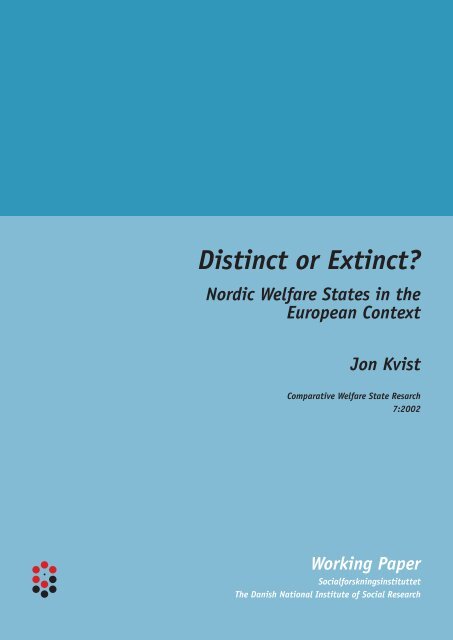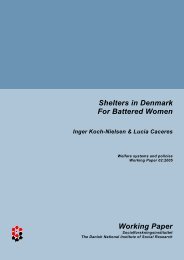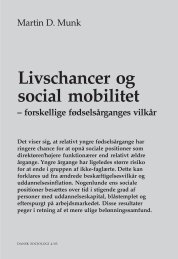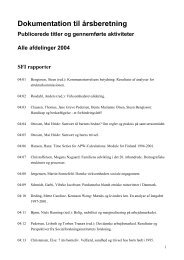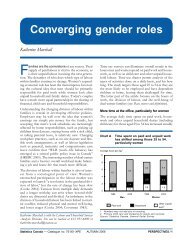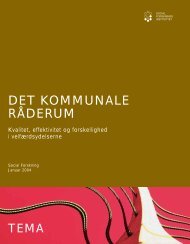Distinct or Extinct? Nordic Welfare States in the European ... - SFI
Distinct or Extinct? Nordic Welfare States in the European ... - SFI
Distinct or Extinct? Nordic Welfare States in the European ... - SFI
Create successful ePaper yourself
Turn your PDF publications into a flip-book with our unique Google optimized e-Paper software.
<strong>Dist<strong>in</strong>ct</strong> <strong>or</strong> <strong>Ext<strong>in</strong>ct</strong>?<br />
N<strong>or</strong>dic <strong>Welfare</strong> <strong>States</strong> <strong>in</strong> <strong>the</strong><br />
<strong>European</strong> Context<br />
Jon Kvist<br />
Comparative <strong>Welfare</strong> State Resarch<br />
7:2002<br />
W<strong>or</strong>k<strong>in</strong>g Paper<br />
Socialf<strong>or</strong>skn<strong>in</strong>gs<strong>in</strong>stituttet<br />
The Danish National Institute of Social Research
<strong>Dist<strong>in</strong>ct</strong> <strong>or</strong> <strong>Ext<strong>in</strong>ct</strong>?<br />
N<strong>or</strong>dic <strong>Welfare</strong> <strong>States</strong> <strong>in</strong> <strong>the</strong><br />
<strong>European</strong> Context<br />
Mikko Kautto & Jon Kvist<br />
Comparative <strong>Welfare</strong> State Research<br />
W<strong>or</strong>k<strong>in</strong>g Paper 07:2002<br />
The W<strong>or</strong>k<strong>in</strong>g Paper Series of The Danish National Institute of Social Research<br />
conta<strong>in</strong> <strong>in</strong>terim results of research and preparat<strong>or</strong>y studies. The W<strong>or</strong>k<strong>in</strong>g Paper<br />
Series provide a basis f<strong>or</strong> professional discussion as part of <strong>the</strong> research process.<br />
Readers should note that results and <strong>in</strong>terpretations <strong>in</strong> <strong>the</strong> f<strong>in</strong>al rep<strong>or</strong>t <strong>or</strong> article<br />
may differ from <strong>the</strong> present W<strong>or</strong>k<strong>in</strong>g Paper. All rights reserved. Sh<strong>or</strong>t sections of<br />
text, not to exceed two paragraphs, may be quoted without explicit permission<br />
provided that full credit, <strong>in</strong>clud<strong>in</strong>g -notice, is given to <strong>the</strong> source.
MIKKO KAUTTO & JON KVIST<br />
DISTINCT OR EXTINCT? NORDIC WELFARE STATES IN THE EUROPEAN CONTEXT<br />
<strong>Dist<strong>in</strong>ct</strong> <strong>or</strong> <strong>Ext<strong>in</strong>ct</strong>? N<strong>or</strong>dic <strong>Welfare</strong> <strong>States</strong> <strong>in</strong> <strong>the</strong> <strong>European</strong> Context<br />
Abstract<br />
Eff<strong>or</strong>ts dur<strong>in</strong>g <strong>the</strong> 1990s to test <strong>the</strong> dismantlement hypo<strong>the</strong>sis led to a ra<strong>the</strong>r broad consensus that <strong>the</strong><br />
welfare state was not be<strong>in</strong>g dismantled <strong>or</strong> retrenched <strong>in</strong> a fundamental manner. Instead, a process of<br />
gradual ref<strong>or</strong>m and revision – re-design <strong>or</strong> re-calibration - was judged to be tak<strong>in</strong>g place. However, as<br />
most studies ei<strong>the</strong>r covered only one <strong>or</strong> a few countries, <strong>or</strong> a s<strong>in</strong>gle welfare state dimension, it rema<strong>in</strong>s<br />
unresolved whe<strong>the</strong>r ref<strong>or</strong>ms affected <strong>the</strong> differences between welfare states <strong>or</strong> types of welfare states:<br />
Did ref<strong>or</strong>ms lead to convergence on <strong>the</strong> <strong>European</strong> scene?<br />
This article offers an empirically-based answer to this question. It gives an account of how ref<strong>or</strong>ms<br />
affected <strong>the</strong> pattern<strong>in</strong>g of <strong>European</strong> welfare states towards <strong>the</strong> late-1990s, based on key f<strong>in</strong>d<strong>in</strong>gs from a<br />
large scale project compar<strong>in</strong>g welfare state adjustment and its consequences <strong>in</strong> several dimensions<br />
among Western <strong>European</strong> welfare states over <strong>the</strong> past two decades.<br />
The present focus is on <strong>the</strong> N<strong>or</strong>dic welfare states <strong>in</strong> a comparative perspective that <strong>in</strong>cludes <strong>the</strong><br />
situation <strong>in</strong> Germany, <strong>the</strong> Ne<strong>the</strong>rlands and <strong>the</strong> United K<strong>in</strong>gdom. The comprehensive nature of <strong>the</strong><br />
N<strong>or</strong>dic welfare model and <strong>the</strong> diverse political and economic challenges recently experienced by <strong>the</strong><br />
N<strong>or</strong>dic countries provide an almost lab<strong>or</strong>at<strong>or</strong>y-like sett<strong>in</strong>g f<strong>or</strong> address<strong>in</strong>g questions of welfare state<br />
challenge, change and convergence. The central question addressed here is whe<strong>the</strong>r <strong>the</strong> radically new<br />
conditions of <strong>the</strong> early-1990s have resulted <strong>in</strong> fundamental changes to exist<strong>in</strong>g policy practice <strong>in</strong> <strong>the</strong><br />
N<strong>or</strong>dic countries and, as a result, <strong>in</strong> convergence with<strong>in</strong> <strong>the</strong> <strong>European</strong> Union? The brief answer is:<br />
Hardly. The f<strong>in</strong>d<strong>in</strong>gs <strong>in</strong>stead suggest that i) a dist<strong>in</strong>ct N<strong>or</strong>dic welfare model can still be identified, ii)<br />
country differences have persisted, and iii) <strong>the</strong> last 20 years of development have thus not led to a<br />
dismantlement n<strong>or</strong> ’<strong>European</strong>isation’ of N<strong>or</strong>dic welfare states.
MIKKO KAUTTO & JON KVIST<br />
DISTINCT OR EXTINCT? NORDIC WELFARE STATES IN THE EUROPEAN CONTEXT<br />
<strong>Dist<strong>in</strong>ct</strong> <strong>or</strong> <strong>Ext<strong>in</strong>ct</strong>? N<strong>or</strong>dic <strong>Welfare</strong> <strong>States</strong><br />
<strong>in</strong> <strong>the</strong> <strong>European</strong> Context<br />
Introduction 1<br />
Towards <strong>the</strong> end of <strong>the</strong> 1990s <strong>the</strong>re emerged a ra<strong>the</strong>r broad consensus among comparative welfare<br />
state researchers that <strong>the</strong> welfare state is not be<strong>in</strong>g dismantled <strong>or</strong> retrenched <strong>in</strong> a fundamental manner<br />
(Palier 2001). Recent large-scale empirical comparative studies have shown that <strong>the</strong> welfare state is<br />
ra<strong>the</strong>r undergo<strong>in</strong>g a process of gradual ref<strong>or</strong>ms and revisions (Pierson 2001, Ferrera et al 2000, Kautto<br />
et al 1999, 2001, Kuhnle 2001, Scharpf & Schmidt 2000). To mark this shift <strong>in</strong> emphasis <strong>the</strong> present era<br />
of welfare state development is described <strong>in</strong> terms of restructur<strong>in</strong>g <strong>or</strong> re-calibration. Similarly, we have<br />
witnessed a shift concern<strong>in</strong>g <strong>the</strong> nature and underly<strong>in</strong>g causes of welfare state change. Previously<br />
dom<strong>in</strong>ant talk of ‘welfare state crisis’ has given way to rhet<strong>or</strong>ic favour<strong>in</strong>g welfare state challenges and<br />
pressures f<strong>or</strong> change. In <strong>the</strong> 1970s and 1980s neo-classical economists, Marxist sociologists and<br />
political scientists alike all predicted that <strong>the</strong> capitalist welfare state would crumble under its own weight<br />
due to crowd<strong>in</strong>g out of private <strong>in</strong>vestments, m<strong>or</strong>al decay, contradictions and government overload.<br />
Today, globalisation, age<strong>in</strong>g populations and chang<strong>in</strong>g family and labour market structures are<br />
p<strong>or</strong>trayed as <strong>the</strong> most press<strong>in</strong>g problems. These changes <strong>in</strong> emphasis signal that <strong>the</strong> imm<strong>in</strong>ent death of<br />
<strong>the</strong> welfare state has been postponed, that <strong>the</strong> welfare state may be <strong>the</strong> cure f<strong>or</strong> overcom<strong>in</strong>g problems<br />
ra<strong>the</strong>r than <strong>the</strong>ir cause, and that eff<strong>or</strong>ts should be devoted to analys<strong>in</strong>g <strong>the</strong> pressures on <strong>the</strong> welfare<br />
state aris<strong>in</strong>g from exogenous fact<strong>or</strong>s, on top of m<strong>or</strong>e endogenous ones (Esp<strong>in</strong>g-Andersen 1999, Jæger<br />
& Kvist 2000).<br />
1
MIKKO KAUTTO & JON KVIST<br />
DISTINCT OR EXTINCT? NORDIC WELFARE STATES IN THE EUROPEAN CONTEXT<br />
While arguably such a shift of emphasis may be detected, <strong>the</strong>re are a number of unanswered questions<br />
<strong>in</strong> <strong>the</strong> comparative literature. In particular, it is still unclear whe<strong>the</strong>r <strong>the</strong> ref<strong>or</strong>ms of <strong>the</strong> last two decades<br />
took place without affect<strong>in</strong>g <strong>the</strong> differences between welfare states <strong>or</strong> types of welfare states, <strong>or</strong><br />
whe<strong>the</strong>r <strong>the</strong>y <strong>in</strong>stead led to convergence, i.e. decreas<strong>in</strong>g differences between welfare states and types of<br />
welfare states. On one side, scholars emphasis<strong>in</strong>g <strong>the</strong> imp<strong>or</strong>tance of <strong>in</strong>stitutional fact<strong>or</strong>s such as <strong>the</strong><br />
political system, <strong>the</strong> labour market and <strong>the</strong> welfare state itself, tend to argue that ref<strong>or</strong>ms took place<br />
with<strong>in</strong> specific regimes (e.g., Esp<strong>in</strong>g-Andersen 1999, Pierson 2001). This strand of th<strong>in</strong>k<strong>in</strong>g suggests<br />
developments are regime-specific, <strong>or</strong> path-dependent. On <strong>the</strong> o<strong>the</strong>r hand, such views have been<br />
challenged by positions stress<strong>in</strong>g <strong>the</strong> imp<strong>or</strong>tance of external challenges that will eventually lead to<br />
convergence between different types of welfare states (see Alber and Stand<strong>in</strong>g 2000).<br />
In this article we exam<strong>in</strong>e how recent ref<strong>or</strong>ms have affected <strong>the</strong> pattern<strong>in</strong>g of welfare states, with<br />
special emphasis on <strong>the</strong> issue of convergence. The article rests on empirical analyses concern<strong>in</strong>g<br />
patterns of welfare state adjustment <strong>in</strong> certa<strong>in</strong> Western <strong>European</strong> countries. The analyses were carried<br />
out by some 20 researchers from seven countries to exam<strong>in</strong>e <strong>the</strong> issue of divergence and convergence<br />
<strong>in</strong> several welfare state dimensions (Kautto et al 2001). In this article we track patterns and trends from<br />
a diversity-<strong>or</strong>iented perspective that builds on <strong>the</strong> results obta<strong>in</strong>ed <strong>in</strong> <strong>the</strong> <strong>in</strong>dividual studies.<br />
The article proceeds as follows: <strong>in</strong> <strong>the</strong> next section, we clarify <strong>the</strong> motivation and means of analysis f<strong>or</strong><br />
study<strong>in</strong>g welfare ref<strong>or</strong>m <strong>in</strong> <strong>the</strong> N<strong>or</strong>dic countries <strong>in</strong> <strong>the</strong> 1990s from a comparative perspective. We <strong>the</strong>n<br />
<strong>in</strong>vestigate <strong>the</strong> nature and direction of trends <strong>in</strong> <strong>the</strong> means and ends of welfare states, compar<strong>in</strong>g <strong>the</strong><br />
situation of <strong>the</strong> N<strong>or</strong>dic countries with that prevail<strong>in</strong>g <strong>in</strong> Germany, <strong>the</strong> Ne<strong>the</strong>rlands and <strong>the</strong> United<br />
K<strong>in</strong>gdom. F<strong>in</strong>ally, this enables us to discuss whe<strong>the</strong>r <strong>the</strong> N<strong>or</strong>dic countries at <strong>the</strong> end of <strong>the</strong> 1990s,<br />
given all <strong>the</strong> recent challenges and ref<strong>or</strong>ms, rema<strong>in</strong>ed dist<strong>in</strong>ct from o<strong>the</strong>r welfare states.<br />
2
MIKKO KAUTTO & JON KVIST<br />
DISTINCT OR EXTINCT? NORDIC WELFARE STATES IN THE EUROPEAN CONTEXT<br />
The N<strong>or</strong>dic welfare states <strong>in</strong> <strong>the</strong> 1990s<br />
Hist<strong>or</strong>ically, <strong>the</strong> Liberal, Social Democratic and Conservative welfare regimes have resulted from<br />
different hist<strong>or</strong>ical f<strong>or</strong>ces, <strong>in</strong>clud<strong>in</strong>g <strong>in</strong>stitutional legacies and <strong>the</strong> mobilisation of political classes<br />
(Esp<strong>in</strong>g-Andersen 1990, 1999). They have followed qualitatively different development traject<strong>or</strong>ies, are<br />
<strong>or</strong>ganised acc<strong>or</strong>d<strong>in</strong>g to <strong>the</strong>ir own logic, and produce different outcomes. The existence of a dist<strong>in</strong>ct<br />
'N<strong>or</strong>dic welfare model' is widely acknowledged and fur<strong>the</strong>r solidified by Esp<strong>in</strong>g-Andersen's Social<br />
Democratic regime (1990, 1999), and <strong>in</strong>deed <strong>the</strong> N<strong>or</strong>dic countries have been <strong>the</strong> most dist<strong>in</strong>ctive of all<br />
country groups identified <strong>in</strong> <strong>the</strong> literature (Castles 1993, xxi). The N<strong>or</strong>dic welfare model is characterised<br />
<strong>in</strong>ter alia by mobilisation of w<strong>or</strong>kers and women that have <strong>in</strong>fluenced <strong>the</strong> development f<strong>or</strong> a broad<br />
scope of public social policy, a political commitment to full employment and reduction of <strong>in</strong>equalities<br />
on several fronts (e.g. gender, <strong>in</strong>come, family situation, region). The model is associated with high social<br />
expenditure, public f<strong>in</strong>anc<strong>in</strong>g and high taxes. In addition to a universal and generous <strong>in</strong>come transfer<br />
system, <strong>the</strong> N<strong>or</strong>dic model has featured local and publicly funded social and health care service<br />
production to cater f<strong>or</strong> all needs and <strong>the</strong> whole population (see Erikson et al 1987, Kolberg 1991,<br />
Kangas 1994, Sipilä 1997, K<strong>or</strong>pi and Palme 1998, Kautto et al 1999, Kvist 1999). With regard to<br />
outcomes, <strong>the</strong> N<strong>or</strong>dic model should achieve low <strong>in</strong>come and gender <strong>in</strong>equality, low poverty rates and<br />
small disparities <strong>in</strong> liv<strong>in</strong>g standards. M<strong>or</strong>eover, <strong>the</strong>se various attributes are thought to <strong>in</strong>teract and<br />
re<strong>in</strong>f<strong>or</strong>ce each o<strong>the</strong>r, only toge<strong>the</strong>r constitut<strong>in</strong>g <strong>the</strong> whole that we may describe as <strong>the</strong> N<strong>or</strong>dic model<br />
(Esp<strong>in</strong>g-Andersen and K<strong>or</strong>pi 1987, Kvist 1999).<br />
Crucially, it is <strong>the</strong>se characteristics that allow <strong>the</strong> N<strong>or</strong>dic welfare model to be commonly p<strong>or</strong>trayed as<br />
‘big and fat’ compared to <strong>the</strong> m<strong>or</strong>e mean and lean models <strong>in</strong> Atlantic and Cont<strong>in</strong>ental <strong>European</strong><br />
countries. Thus, <strong>in</strong> so far as current challenges translate <strong>in</strong>to trimm<strong>in</strong>g <strong>the</strong> welfare state, <strong>the</strong> N<strong>or</strong>dic<br />
countries would be <strong>the</strong> most likely candidates to undertake such measures with speed and<br />
determ<strong>in</strong>ation. This could lead to a s<strong>or</strong>t of downward convergence of <strong>the</strong> N<strong>or</strong>dic welfare states.<br />
Indeed, f<strong>or</strong> an empirical exam<strong>in</strong>ation of such claims, <strong>the</strong> four N<strong>or</strong>dic countries of Denmark, F<strong>in</strong>land,<br />
3
MIKKO KAUTTO & JON KVIST<br />
DISTINCT OR EXTINCT? NORDIC WELFARE STATES IN THE EUROPEAN CONTEXT<br />
N<strong>or</strong>way and Sweden offer a unique lab<strong>or</strong>at<strong>or</strong>y-like sett<strong>in</strong>g due to <strong>the</strong>ir differ<strong>in</strong>g national social,<br />
economic and political developments <strong>in</strong> <strong>the</strong> 1980s and 1990s.<br />
The maj<strong>or</strong> political, economic and social upheavals that occurred <strong>in</strong> Europe at <strong>the</strong> beg<strong>in</strong>n<strong>in</strong>g of <strong>the</strong><br />
1990s also affected <strong>the</strong> prospects of <strong>the</strong> N<strong>or</strong>dic countries. The collapse of <strong>the</strong> Soviet bloc and bi-polar<br />
w<strong>or</strong>ld <strong>or</strong>der triggered transition processes towards a new w<strong>or</strong>ld <strong>or</strong>der. Western <strong>European</strong> nation-states<br />
responded with calls f<strong>or</strong> a m<strong>or</strong>e <strong>in</strong>tegrated Europe, both politically and economically. In <strong>the</strong> n<strong>or</strong><strong>the</strong>rn<br />
c<strong>or</strong>ner of Western Europe, Sweden, F<strong>in</strong>land and N<strong>or</strong>way revised <strong>the</strong>ir policy; F<strong>in</strong>land and Sweden<br />
became EU members, while N<strong>or</strong>way opted to co-operate with<strong>in</strong> <strong>the</strong> EEA-agreement. In terms of<br />
domestic policy <strong>the</strong> 1990s challenged <strong>the</strong> rul<strong>in</strong>g position of <strong>the</strong> social democrats <strong>in</strong> <strong>the</strong> governments of<br />
<strong>the</strong>se countries. Denmark was <strong>the</strong> sole N<strong>or</strong>dic member of <strong>the</strong> EU at <strong>the</strong> start of <strong>the</strong> 1990s and first of<br />
<strong>the</strong> N<strong>or</strong>dic group to experience a shift from Conservative-led to Social Democratic-led coalition<br />
government <strong>in</strong> <strong>the</strong> 1990s. Increased mobility of capital, <strong>in</strong>ternationalis<strong>in</strong>g markets and technological<br />
progress generated debate on globalisation and its impacts. The early years of <strong>the</strong> last decade also saw a<br />
slump <strong>in</strong> <strong>the</strong> global economy. Nowhere <strong>in</strong> <strong>the</strong> <strong>in</strong>dustrialised w<strong>or</strong>ld was this m<strong>or</strong>e visible than <strong>in</strong> F<strong>in</strong>land<br />
and Sweden. These countries witnessed three consecutive years of macro-economic decl<strong>in</strong>e measured<br />
<strong>in</strong> GDP terms, and <strong>the</strong>ir unemployment rates <strong>in</strong>creased almost five-fold between 1990 and 1993, with<br />
parallel decl<strong>in</strong>es <strong>in</strong> employment. Unemployment also rose <strong>in</strong> N<strong>or</strong>way, and <strong>in</strong> many respects <strong>the</strong><br />
experiences of Denmark <strong>in</strong> <strong>the</strong> 1980s were now extended to <strong>the</strong> three o<strong>the</strong>r N<strong>or</strong>dic countries.<br />
Naturally enough, attention from many quarters was beg<strong>in</strong>n<strong>in</strong>g to ask to whe<strong>the</strong>r <strong>the</strong>se radically new<br />
conditions also implied fundamental changes to exist<strong>in</strong>g policy practice <strong>in</strong> <strong>the</strong> N<strong>or</strong>dic countries. The<br />
N<strong>or</strong>dic welfare model was certa<strong>in</strong>ly be<strong>in</strong>g challenged. The steady economic growth and high, if not full,<br />
employment that were generally seen as c<strong>or</strong>nerstones of <strong>the</strong> model suddenly appeared to belong to <strong>the</strong><br />
past. The consequent fiscal problems placed policy makers <strong>in</strong> a new situation: <strong>in</strong>stead of policy ref<strong>or</strong>ms<br />
to guarantee m<strong>or</strong>e and better 'social rights', cuts and o<strong>the</strong>r balanc<strong>in</strong>g measures were considered, and an<br />
4
MIKKO KAUTTO & JON KVIST<br />
DISTINCT OR EXTINCT? NORDIC WELFARE STATES IN THE EUROPEAN CONTEXT<br />
emphasis on 'social duties' <strong>in</strong> <strong>the</strong> f<strong>or</strong>m of <strong>in</strong>creased taxes and social contributions as well as tougher<br />
w<strong>or</strong>k obligations and m<strong>or</strong>al responsibilities became m<strong>or</strong>e prevalent.<br />
From challenges to ref<strong>or</strong>ms, from ref<strong>or</strong>ms to convergence?<br />
In <strong>the</strong> N<strong>or</strong>dic context, <strong>the</strong> pressures to carry out <strong>the</strong> ref<strong>or</strong>ms were often f<strong>or</strong>mulated with reference to<br />
external challenges. F<strong>or</strong> many years critics have argued that <strong>the</strong> N<strong>or</strong>dic welfare states have excessive<br />
taxation, over-rigid legislation, stagnant <strong>in</strong>stitutions and too much public <strong>in</strong>volvement. They are said to<br />
spend too much on welfare, give <strong>the</strong> wrong <strong>in</strong>centives regard<strong>in</strong>g participation <strong>in</strong> paid employment and<br />
family f<strong>or</strong>mation, and by hav<strong>in</strong>g loose entrance criteria f<strong>or</strong> benefits - and high levels of benefits - <strong>the</strong>y<br />
are said to promote welfare dependency. In <strong>the</strong> 1990s such criticisms were rallied to <strong>the</strong> cause of<br />
economic globalisation. It was argued that <strong>in</strong> an ever m<strong>or</strong>e global and competitive environment where<br />
firms and employees are m<strong>or</strong>e dynamic, and where capital and goods move freely across b<strong>or</strong>ders, such<br />
a ‘slack’ system is no longer suitable n<strong>or</strong> susta<strong>in</strong>able.<br />
Ano<strong>the</strong>r substantial issue <strong>in</strong> <strong>the</strong> 1990s was <strong>the</strong> effect of <strong>European</strong> political <strong>in</strong>tegration, <strong>or</strong> m<strong>or</strong>e<br />
specifically of <strong>the</strong> EU and EMU, on <strong>the</strong> policies of member states. While globalisation is supposed to<br />
impact welfare states ma<strong>in</strong>ly through un<strong>in</strong>tended consequences, here it is m<strong>or</strong>e a question of <strong>in</strong>tentional<br />
eff<strong>or</strong>ts at a supra-national level to achieve ‘harmonisation’ and ‘co-<strong>or</strong>d<strong>in</strong>ation’ between <strong>the</strong> members.<br />
Most agree that <strong>in</strong> <strong>the</strong> social dimension nation-states rema<strong>in</strong> sovereign act<strong>or</strong>s, but views are at variance<br />
regard<strong>in</strong>g <strong>the</strong> spill-over effects of economic <strong>in</strong>tegration. Some auth<strong>or</strong>s warn of <strong>the</strong> pressure towards<br />
greater similarities <strong>in</strong> economic and fiscal policies, <strong>in</strong>stitutional arrangements and levels of provision <strong>in</strong><br />
<strong>the</strong> EU member states (Hagen 1999, Leibfried and Pierson 2000, Scharpf 1999, Streeck 1996). A<br />
suggestion from many quarters is that <strong>the</strong> governments of <strong>the</strong> member states should agree on some<br />
jo<strong>in</strong>t objectives and standards <strong>in</strong> <strong>the</strong> social dimension, o<strong>the</strong>rwise this pressure may make it difficult f<strong>or</strong><br />
<strong>the</strong> countries with <strong>the</strong> most generous provisions to susta<strong>in</strong> <strong>the</strong>m. In sum, dur<strong>in</strong>g <strong>the</strong> 1990s reference to<br />
‘external pressures’ began to supplement established criticism aga<strong>in</strong>st welfare state arrangements based<br />
5
MIKKO KAUTTO & JON KVIST<br />
DISTINCT OR EXTINCT? NORDIC WELFARE STATES IN THE EUROPEAN CONTEXT<br />
on <strong>in</strong>ternal pressures (see also Alber 1988, M<strong>or</strong>an 1988, Esp<strong>in</strong>g-Andersen 1999, Jæger and Kvist 2000,<br />
Van Kersbergen 2000).<br />
There is no doubt that such challenges – whe<strong>the</strong>r real <strong>or</strong> not - impelled policy makers to consider and<br />
<strong>in</strong>troduce ref<strong>or</strong>ms. But what impact <strong>the</strong>se ref<strong>or</strong>ms had on <strong>the</strong> prevail<strong>in</strong>g divergence among <strong>European</strong><br />
welfare states is ano<strong>the</strong>r question. Those sceptical of <strong>the</strong> dist<strong>in</strong>ctiveness of <strong>the</strong> N<strong>or</strong>dic welfare states<br />
expect some convergence (result<strong>in</strong>g <strong>in</strong> less variation) of policies to occur, ei<strong>the</strong>r explicitly <strong>or</strong> implicitly.<br />
However, dissent<strong>in</strong>g views have also appeared. Attention has been drawn to <strong>the</strong> fact that many of <strong>the</strong><br />
countries that have long been highly exposed to <strong>in</strong>ternational trade competition, such as <strong>the</strong> small and<br />
open N<strong>or</strong>dic economies, also tend to have ‘larger’ welfare states (Katzenste<strong>in</strong> 1985, Mjøset et al 1986,<br />
Garrett 1998, Gough 1999, Stephens et al 1999). Several scholars express scepticism about <strong>the</strong> impact<br />
of globalisation on <strong>the</strong> capabilities of national governments to pursue <strong>the</strong>ir own social and welfare<br />
policies, and argue that <strong>the</strong> welfare states of Western Europe are likely to survive globalisation (Hirst<br />
and Thompson 2000, Kuhnle 2000, Ferrera et al 2000). In this view, national politicians, ra<strong>the</strong>r than<br />
supra-national f<strong>or</strong>ces, cont<strong>in</strong>ue to decide <strong>the</strong> fate of <strong>the</strong> welfare state, <strong>in</strong>stitutions rema<strong>in</strong> slow to<br />
change, and public supp<strong>or</strong>t f<strong>or</strong> welfare state measures makes radical ref<strong>or</strong>ms a difficult enterprise<br />
(Pierson 2001).<br />
This type of debate is rem<strong>in</strong>iscent of older juxtapositions <strong>in</strong> welfare state <strong>the</strong><strong>or</strong>is<strong>in</strong>g. The first<br />
generation of comparative welfare state studies typically saw welfare state development as a response to<br />
chang<strong>in</strong>g societal processes, although <strong>the</strong>re were different variants of this general functionalist<br />
hypo<strong>the</strong>sis. Acc<strong>or</strong>d<strong>in</strong>g to <strong>the</strong> logic of <strong>in</strong>dustrialism and modernisation <strong>the</strong><strong>or</strong>y technological and<br />
economic rationality pressed f<strong>or</strong> convergence <strong>in</strong> all <strong>in</strong>dustrialised societies. It was argued that economic<br />
development both produces <strong>the</strong> wealth necessary f<strong>or</strong> welfare provision and <strong>the</strong> need f<strong>or</strong> it, as <strong>the</strong><br />
population ages and traditional social netw<strong>or</strong>ks erode <strong>in</strong> parallel with <strong>the</strong> processes of <strong>in</strong>dustrialisation<br />
and urbanisation (e.g. Wilensky 1975, Fl<strong>or</strong>a and Alber 1981). In an equally functionalist way, Marxists<br />
6
MIKKO KAUTTO & JON KVIST<br />
DISTINCT OR EXTINCT? NORDIC WELFARE STATES IN THE EUROPEAN CONTEXT<br />
saw <strong>the</strong> development as a feature of modern capitalism (e.g. O’Conn<strong>or</strong> 1973). Hav<strong>in</strong>g been subject to<br />
severe criticism from many quarters <strong>the</strong> idea of convergence was largely neglected <strong>in</strong> <strong>the</strong> 1980s, but<br />
received fresh attention <strong>in</strong> <strong>the</strong> 1990s, albeit <strong>in</strong> revised f<strong>or</strong>m.<br />
The current convergence <strong>the</strong>sis tends to evolve around arguments stress<strong>in</strong>g fact<strong>or</strong>s beyond nationstates,<br />
such as <strong>in</strong>ternationalisation, geopolitical transf<strong>or</strong>mation, technological revolution, liberalised<br />
money and capital markets, as well as a globalised culture. Montanari (2000) identifies ano<strong>the</strong>r<br />
difference: whereas <strong>the</strong> old convergence <strong>the</strong><strong>or</strong>y expla<strong>in</strong>ed <strong>the</strong> emergence and expansion of <strong>the</strong> welfare<br />
state, <strong>the</strong> new convergence <strong>the</strong>sis underp<strong>in</strong>s views that emphasise <strong>the</strong> curtailment of welfare states.<br />
However, it should be mentioned here that on closer exam<strong>in</strong>ation <strong>the</strong>re is no s<strong>in</strong>gle convergence <strong>the</strong>sis<br />
<strong>or</strong> <strong>the</strong><strong>or</strong>y, but ra<strong>the</strong>r a multitude of various views on impact mechanisms and <strong>the</strong>ir outcomes.<br />
Sometimes convergence is <strong>in</strong>terpreted to mean a move towards a <strong>European</strong> average, <strong>or</strong> even a<br />
m<strong>in</strong>imum. If <strong>the</strong>se were <strong>the</strong> c<strong>or</strong>rect <strong>in</strong>terpretations, convergence from a N<strong>or</strong>dic perspective would<br />
mean a ‘<strong>European</strong>isation’ of <strong>the</strong> N<strong>or</strong>dic welfare states (Hagen 1999). However, convergence may also<br />
occur if o<strong>the</strong>r Western <strong>European</strong> countries start to adopt policies and arrangements already<br />
<strong>in</strong>stitutionalised <strong>in</strong> <strong>the</strong> N<strong>or</strong>dic countries; this is referred to as ‘catch-up convergence’ (see e.g. Greve<br />
1996, Alber and Stand<strong>in</strong>g 2000, Guillén and Matsaganis 2000).<br />
The<strong>or</strong>etically, variants of <strong>the</strong> convergence <strong>the</strong>sis are challenged by auth<strong>or</strong>s stress<strong>in</strong>g cont<strong>in</strong>u<strong>in</strong>g<br />
differences. Today it is largely accepted that <strong>European</strong> welfare states have, f<strong>or</strong> a variety of hist<strong>or</strong>ical,<br />
economic and political reasons, developed different welfare regimes that l<strong>in</strong>k <strong>the</strong> function<strong>in</strong>g of social<br />
<strong>in</strong>stitutions (labour market, welfare state and family/household) <strong>in</strong> various ways. In <strong>the</strong>se<br />
circumstances, 'common challenges' <strong>in</strong> fact become regime-specific challenges (Esp<strong>in</strong>g-Andersen 1999),<br />
as <strong>the</strong>y are 'filtered' by national traditions, <strong>in</strong>stitutions and <strong>in</strong>terests (Ferrera et al 2000). M<strong>or</strong>eover, <strong>the</strong><br />
exist<strong>in</strong>g <strong>in</strong>stitutional configuration imposes limits on available policy options (Pierson 2001), which also<br />
<strong>in</strong>fluences <strong>the</strong> process of restructur<strong>in</strong>g. Consequently, it is argued that policy adaptation becomes 'path-<br />
7
MIKKO KAUTTO & JON KVIST<br />
DISTINCT OR EXTINCT? NORDIC WELFARE STATES IN THE EUROPEAN CONTEXT<br />
dependent', <strong>or</strong> follows regime-specific logic, and that ref<strong>or</strong>ms tend to be <strong>in</strong>cremental ra<strong>the</strong>r than<br />
radical, possibly even to <strong>the</strong> extent of lock<strong>in</strong>g exist<strong>in</strong>g policy arrangements <strong>in</strong>to place (Pierson 2001).<br />
Hence, stability rules ra<strong>the</strong>r than change when it comes to differences between regimes.<br />
Divergence <strong>or</strong> convergence?<br />
On <strong>the</strong> basis of f<strong>in</strong>d<strong>in</strong>gs obta<strong>in</strong>ed <strong>in</strong> a recent empirical cross-national analysis of welfare state<br />
developments <strong>in</strong> <strong>the</strong> N<strong>or</strong>dic countries and Western Europe, particularly Germany, <strong>the</strong> Ne<strong>the</strong>rlands and<br />
<strong>the</strong> United K<strong>in</strong>gdom, we now turn to analyse whe<strong>the</strong>r <strong>the</strong>re are signs of divergence <strong>or</strong> convergence<br />
between different types of welfare states. 2 In particular, we consider different dimensions of welfare<br />
state change as <strong>the</strong>y relate to <strong>in</strong>terplay between <strong>the</strong> state and <strong>the</strong> market, between <strong>the</strong> state and <strong>the</strong><br />
family, and regard<strong>in</strong>g welfare state outcomes. Consider<strong>in</strong>g <strong>the</strong> first dimension, state-market <strong>in</strong>terplay,<br />
<strong>the</strong> follow<strong>in</strong>g analysis draws on studies on f<strong>in</strong>anc<strong>in</strong>g of social protection, activation policies and<br />
changes <strong>in</strong> unemployment compensation schemes. The relationship between <strong>the</strong> family and <strong>the</strong> state is<br />
exam<strong>in</strong>ed <strong>in</strong> studies on family policies, gender policies and services. And <strong>in</strong> terms of outcomes we refer<br />
to studies on <strong>in</strong>come distribution, gender equality and health <strong>in</strong>equalities (see Kautto et al 2001).<br />
A prelim<strong>in</strong>ary conclusion is that empirical analyses of welfare state developments <strong>in</strong> <strong>the</strong>se dimensions<br />
display greater complexity and ambiguity regard<strong>in</strong>g variation and trends than <strong>the</strong> arguments f<strong>or</strong><br />
‘<strong>in</strong>stitutional <strong>in</strong>ertia’ and ‘new convergence’, as set out above, suggest. When simultaneous attention is<br />
focused on developments across a wide spectrum of welfare state activities and outcomes, a picture of<br />
both divergence and convergence emerges that renders <strong>in</strong>valid any universal claim <strong>in</strong> favour of ei<strong>the</strong>r<br />
path-dependency <strong>or</strong> convergence. Whereas <strong>the</strong> above <strong>the</strong><strong>or</strong>etical ideas and hypo<strong>the</strong>sis are general <strong>in</strong><br />
nature, our empirical <strong>in</strong>vestigations show that it is possible to f<strong>in</strong>d contradict<strong>or</strong>y cases <strong>in</strong> nearly all<br />
dimensions of <strong>the</strong> welfare state.<br />
8
MIKKO KAUTTO & JON KVIST<br />
DISTINCT OR EXTINCT? NORDIC WELFARE STATES IN THE EUROPEAN CONTEXT<br />
However, if we absta<strong>in</strong> from <strong>the</strong> goal of f<strong>or</strong>mulat<strong>in</strong>g and falsify<strong>in</strong>g universal laws on welfare state<br />
developments, and <strong>in</strong>stead aim at middle-range generalisations, we can <strong>in</strong>deed reach conclusions<br />
regard<strong>in</strong>g group similarity and trends. A necessarily modest summary of such f<strong>in</strong>d<strong>in</strong>gs is provided <strong>in</strong><br />
Table 1. The ma<strong>in</strong> conclusions are i) a dist<strong>in</strong>ct N<strong>or</strong>dic welfare model can be identified, ii) due to parallel<br />
ra<strong>the</strong>r than converg<strong>in</strong>g trends country differences have persisted, and iii) <strong>the</strong> last twenty years of<br />
development have not led to dismantlement n<strong>or</strong> ’<strong>European</strong>isation’ of N<strong>or</strong>dic welfare states.<br />
Table 1. N<strong>or</strong>dic welfare states <strong>in</strong> <strong>the</strong> <strong>European</strong> context<br />
Research question<br />
Are N<strong>or</strong>dic social policy and welfare (still) dist<strong>in</strong>ct from o<strong>the</strong>r countries?<br />
Focus<br />
Denmark, F<strong>in</strong>land, N<strong>or</strong>way, Sweden, and Germany, <strong>the</strong> Ne<strong>the</strong>rlands, <strong>the</strong> Unitd K<strong>in</strong>gdom<br />
(plus o<strong>the</strong>r countries) 1980-late 1990s<br />
Research areas Policy change <strong>Welfare</strong> outcomes<br />
Ma<strong>in</strong> f<strong>in</strong>d<strong>in</strong>gs<br />
Overall conclusions<br />
Almost identical development paths<br />
<strong>in</strong> gender policy processes among <strong>the</strong><br />
N<strong>or</strong>dic countries;<br />
All still qualify as ’service states’;<br />
While all countries placed greater<br />
emphasis on w<strong>or</strong>k when design<strong>in</strong>g <strong>or</strong><br />
modify<strong>in</strong>g <strong>the</strong>ir employment-related<br />
benefits, <strong>the</strong> end-result can still be<br />
<strong>in</strong>terpreted as endur<strong>in</strong>g diversity<br />
because of <strong>the</strong> differ<strong>in</strong>g speed and<br />
context of changes<br />
-> M<strong>or</strong>e evidence f<strong>or</strong> N<strong>or</strong>dic<br />
similarity than dissimilarity;<br />
Parallel trends, ra<strong>the</strong>r than<br />
convergence<br />
The N<strong>or</strong>dic countries display a lower level of <strong>in</strong>come<br />
<strong>in</strong>equality;<br />
Relative poverty rates among typically vulnerable<br />
groups still appear to be lower than <strong>in</strong> o<strong>the</strong>r<br />
countries;<br />
F<strong>or</strong> gender equality a N<strong>or</strong>dic unity seems to exist: <strong>in</strong><br />
terms of earn<strong>in</strong>gs differentials between men and<br />
women and degree of economic dependence among<br />
spouses all four N<strong>or</strong>dic countries are dist<strong>in</strong>ct from<br />
o<strong>the</strong>rs<br />
-> Persist<strong>in</strong>g diversity <strong>in</strong> Western Europe and<br />
systematic similarities among <strong>the</strong> N<strong>or</strong>dic countries;<br />
M<strong>or</strong>e signs of cont<strong>in</strong>u<strong>in</strong>g divergence than of convergence.<br />
When convergence could be detected, it resembled ’catch-up’ convergence ra<strong>the</strong>r than a<br />
dismantlement <strong>or</strong> <strong>European</strong>isation of N<strong>or</strong>dic welfare policies.<br />
Evidence that <strong>the</strong> N<strong>or</strong>dic model is and rema<strong>in</strong>s dist<strong>in</strong>ct.<br />
No evidence of <strong>the</strong> N<strong>or</strong>dic model becom<strong>in</strong>g ext<strong>in</strong>ct.<br />
Firstly, regard<strong>in</strong>g collective similarity, <strong>the</strong> N<strong>or</strong>dic countries as a group still tended to be different from<br />
o<strong>the</strong>r Western <strong>European</strong> countries <strong>in</strong> key dimensions of policy and welfare. This does not imply <strong>the</strong>y<br />
were similar <strong>in</strong> all respects, as significant differences <strong>in</strong> <strong>the</strong> degree and f<strong>or</strong>m of adaptation and policy<br />
responses could also be found. Yet, <strong>in</strong> most dimensions <strong>the</strong> N<strong>or</strong>dic countries did group toge<strong>the</strong>r. In<br />
our analysis similarities appeared most strik<strong>in</strong>g <strong>in</strong> <strong>the</strong> levels and distribution of welfare, ra<strong>the</strong>r than <strong>in</strong><br />
policies; systematic similarities could be detected <strong>in</strong> <strong>in</strong>come distribution, poverty and gender equality. In<br />
comparison with o<strong>the</strong>r countries <strong>the</strong> N<strong>or</strong>dic states <strong>in</strong> <strong>the</strong> mid/late-1990s were still characterised by less<br />
9
MIKKO KAUTTO & JON KVIST<br />
DISTINCT OR EXTINCT? NORDIC WELFARE STATES IN THE EUROPEAN CONTEXT<br />
<strong>in</strong>come <strong>in</strong>equality and lower rates of relative poverty (Fritzell 2001). Gender equality was m<strong>or</strong>e<br />
pronounced, and <strong>in</strong> household-based comparisons N<strong>or</strong>dic women were less dependent on <strong>the</strong>ir<br />
partner’s <strong>in</strong>come than elsewhere (Sørensen 2001).<br />
There was also evidence f<strong>or</strong> <strong>the</strong> dist<strong>in</strong>ctiveness of N<strong>or</strong>dic social policies. An analysis of <strong>the</strong><br />
development of gender policies <strong>in</strong> <strong>the</strong> N<strong>or</strong>dic countries revealed almost identical development paths<br />
(Kjeldstad 2001). Different alternatives f<strong>or</strong> arrang<strong>in</strong>g care f<strong>or</strong> <strong>the</strong> elderly and children could be <strong>the</strong> basis<br />
f<strong>or</strong> argu<strong>in</strong>g that no N<strong>or</strong>dic model exists when it comes to availability of services. Yet, that policies have<br />
developed with<strong>in</strong> a 'social' traject<strong>or</strong>y ra<strong>the</strong>r than with<strong>in</strong> 'education' <strong>or</strong> 'health' reveals someth<strong>in</strong>g dist<strong>in</strong>ct<br />
about <strong>the</strong> N<strong>or</strong>dic countries (Rostgaard and Lehto 2001). M<strong>or</strong>eover, <strong>the</strong>y appear to be cont<strong>in</strong>u<strong>in</strong>g to<br />
solve care needs by provid<strong>in</strong>g publicly run care services. In addition, as a group <strong>the</strong> N<strong>or</strong>dic countries<br />
<strong>in</strong>vested most <strong>in</strong> 'active measures', while <strong>the</strong>ir spend<strong>in</strong>g on 'passive measures' also rema<strong>in</strong>ed <strong>the</strong> highest<br />
(Hv<strong>in</strong>den et al 2001). Use of <strong>the</strong>se examples does not mean we declare <strong>or</strong> imply that <strong>the</strong> N<strong>or</strong>dic<br />
countries were similar <strong>in</strong> all respects. F<strong>or</strong> <strong>in</strong>stance, <strong>the</strong> responses of social security to chang<strong>in</strong>g family<br />
patterns did not follow any typology-specific routes. Here, <strong>in</strong> fact, <strong>the</strong> four N<strong>or</strong>dic countries could be<br />
located <strong>in</strong> three differ<strong>in</strong>g response groups (Hatland 2001). Similarly, f<strong>or</strong> health outcomes one cannot<br />
f<strong>in</strong>d a common N<strong>or</strong>dic pattern (Lundberg and Lahelma 2001).<br />
Secondly, regard<strong>in</strong>g trends, we found little evidence of N<strong>or</strong>dic and non-N<strong>or</strong>dic countries hav<strong>in</strong>g<br />
become m<strong>or</strong>e similar than bef<strong>or</strong>e. The conclusion from our studies is that although convergence does<br />
seem to be occurr<strong>in</strong>g <strong>in</strong> some areas and outcomes of <strong>the</strong> welfare state, overall developments tend to be<br />
characterised m<strong>or</strong>e by parallel trends. All countries placed a greater emphasis on w<strong>or</strong>k on ref<strong>or</strong>ms of<br />
welfare policies. This shows up <strong>in</strong> <strong>the</strong> rhet<strong>or</strong>ic surround<strong>in</strong>g welfare ref<strong>or</strong>ms, but also as <strong>in</strong>creased<br />
demands f<strong>or</strong> previous w<strong>or</strong>k experience f<strong>or</strong> eligibility and entitlements, m<strong>or</strong>e w<strong>or</strong>k availability by social<br />
security claimants, and – <strong>in</strong> some countries - a greater push f<strong>or</strong> activation policies (Clasen et al 2001).<br />
However, different start<strong>in</strong>g po<strong>in</strong>ts among countries f<strong>or</strong> such ref<strong>or</strong>ms, and vary<strong>in</strong>g speed and <strong>in</strong>tensity<br />
10
MIKKO KAUTTO & JON KVIST<br />
DISTINCT OR EXTINCT? NORDIC WELFARE STATES IN THE EUROPEAN CONTEXT<br />
with which <strong>the</strong>y have been undertaken, mean it is m<strong>or</strong>e justified to talk of parallel trends ra<strong>the</strong>r than<br />
convergence of national welfare models.<br />
Similarly, parallel trends were found with regard to welfare outcomes. F<strong>or</strong> <strong>in</strong>stance, although <strong>in</strong>come<br />
differences have been <strong>in</strong>creas<strong>in</strong>g lately <strong>in</strong> <strong>the</strong> N<strong>or</strong>dic countries (with <strong>the</strong> possible exception of<br />
Denmark) no convergence of <strong>in</strong>equality <strong>in</strong> <strong>in</strong>comes was found, despite repeated claims to <strong>the</strong> contrary<br />
(Fritzell 2001). Parallel trends also characterise <strong>the</strong> development <strong>in</strong> earn<strong>in</strong>gs differentials between men<br />
and women (Sørensen 2001). It seems all countries succeeded <strong>in</strong> narrow<strong>in</strong>g <strong>the</strong> gender gap by foster<strong>in</strong>g<br />
m<strong>or</strong>e economic <strong>in</strong>dependence f<strong>or</strong> women, but as a consequence <strong>the</strong> differences between <strong>the</strong> countries<br />
did not change much.<br />
F<strong>in</strong>ally, although parallel trends was <strong>the</strong> overall f<strong>in</strong>d<strong>in</strong>g, a few w<strong>or</strong>ds concern<strong>in</strong>g <strong>the</strong> results supp<strong>or</strong>tive<br />
of convergence are appropriate, given <strong>the</strong> wide-spread anticipation of detrimental effects of<br />
globalisation and <strong>the</strong> EU on N<strong>or</strong>dic-type welfare states. In <strong>the</strong> light of our studies two ra<strong>the</strong>r safe<br />
conclusions can be drawn about <strong>the</strong> nature of converg<strong>in</strong>g trends.<br />
Firstly, aga<strong>in</strong>st widespread expectations, signs of a '<strong>European</strong>isation of N<strong>or</strong>dic social policy' -type of<br />
convergence appear very limited, at least <strong>in</strong> <strong>the</strong> policy fields and with <strong>the</strong> k<strong>in</strong>ds of <strong>in</strong>dicat<strong>or</strong>s and<br />
methods applied <strong>in</strong> our studies. The only clear case of such convergence to emerge is <strong>the</strong> change <strong>in</strong> <strong>the</strong><br />
relative responsibility f<strong>or</strong> f<strong>in</strong>anc<strong>in</strong>g social protection. In <strong>the</strong> light of available data <strong>the</strong> responsibilities of<br />
different parties f<strong>or</strong> f<strong>in</strong>anc<strong>in</strong>g <strong>in</strong> <strong>the</strong> N<strong>or</strong>dic countries now resemble m<strong>or</strong>e <strong>the</strong> picture <strong>in</strong> <strong>the</strong> rest of<br />
Western Europe (Kautto 2001a). To what extent this implies convergence <strong>in</strong> <strong>the</strong> nature of social<br />
protection policies is ano<strong>the</strong>r st<strong>or</strong>y, especially as it seems that no unif<strong>or</strong>m N<strong>or</strong>dic pattern existed <strong>in</strong> <strong>the</strong><br />
first place <strong>in</strong> this respect. Besides, <strong>the</strong> persistent diversity may well outweigh much of <strong>the</strong> gradual<br />
convergence that has taken place.<br />
11
MIKKO KAUTTO & JON KVIST<br />
DISTINCT OR EXTINCT? NORDIC WELFARE STATES IN THE EUROPEAN CONTEXT<br />
Secondly, <strong>the</strong>re are good grounds to argue that when convergence has occurred, it has primarily been<br />
of <strong>the</strong> nature of 'catch-up convergence'. We found that a number of non-N<strong>or</strong>dic countries were<br />
adopt<strong>in</strong>g policy measures similar to those <strong>in</strong> <strong>the</strong> N<strong>or</strong>dic countries. F<strong>or</strong> example, <strong>the</strong> active promotion<br />
of employment and gender equality are m<strong>or</strong>e visible <strong>the</strong>se days on <strong>the</strong> political agendas of many<br />
<strong>European</strong> governments and <strong>in</strong>ternational <strong>or</strong>ganisations than <strong>the</strong>y used to be, with potentially farreach<strong>in</strong>g<br />
consequences f<strong>or</strong> <strong>the</strong> design of supp<strong>or</strong>tive policies <strong>in</strong> Western <strong>European</strong> countries. In terms<br />
of employment opp<strong>or</strong>tunities, especially f<strong>or</strong> women, this seems to have resulted <strong>in</strong> a m<strong>or</strong>e active role<br />
f<strong>or</strong> <strong>the</strong> public sect<strong>or</strong> <strong>in</strong> guarantee<strong>in</strong>g childcare and elderly care. The Ne<strong>the</strong>rlands and France with <strong>the</strong>ir<br />
childcare policies could be named as examples of this s<strong>or</strong>t of development (Rostgaard and Lehto 2001).<br />
In fact, social care services provide an area of analysis where talk of retrenchment is greatly exaggerated,<br />
and where challenges do not seem to lean towards dismantlement but to <strong>in</strong>vestments and improvement<br />
(see Castles 2001, Kautto 2001b, Kvist 2001). M<strong>or</strong>eover, regard<strong>in</strong>g f<strong>in</strong>anc<strong>in</strong>g trends, most <strong>in</strong>dicat<strong>or</strong>s<br />
show it is <strong>the</strong> Sou<strong>the</strong>rn <strong>European</strong> countries that by <strong>in</strong>vest<strong>in</strong>g m<strong>or</strong>e <strong>in</strong> social programmes have<br />
narrowed <strong>the</strong> gap to <strong>the</strong> o<strong>the</strong>r EU member states that used to have higher taxation and social spend<strong>in</strong>g<br />
levels.<br />
Active labour market policies also provide good grounds f<strong>or</strong> argu<strong>in</strong>g that some s<strong>or</strong>t of catch-up<br />
convergence could be tak<strong>in</strong>g place. N<strong>or</strong>dic countries, and especially Sweden as an activation pioneer,<br />
have been promoted as examples of good practice f<strong>or</strong> <strong>the</strong> o<strong>the</strong>r EU member states. Acc<strong>or</strong>d<strong>in</strong>g to<br />
empirical evaluations non-N<strong>or</strong>dic countries like France, Ireland, Italy and <strong>the</strong> Ne<strong>the</strong>rlands did <strong>in</strong>deed<br />
become m<strong>or</strong>e activist <strong>in</strong> <strong>the</strong> last decade (Hv<strong>in</strong>den et al 2001, Clasen et al 2001).<br />
However, it may be too simple to suggest that <strong>the</strong>se examples are signs of convergence just because<br />
changes po<strong>in</strong>t <strong>in</strong> <strong>the</strong> same direction. Ref<strong>or</strong>ms have taken place with<strong>in</strong> different social policy<br />
programmes and still broader contexts (e.g., family and labour market structures). F<strong>or</strong> example, child<br />
day care is much m<strong>or</strong>e universal, highly professional and offered f<strong>or</strong> longer hours <strong>in</strong> <strong>the</strong> N<strong>or</strong>dic<br />
12
MIKKO KAUTTO & JON KVIST<br />
DISTINCT OR EXTINCT? NORDIC WELFARE STATES IN THE EUROPEAN CONTEXT<br />
countries compared to Brita<strong>in</strong> and <strong>the</strong> Ne<strong>the</strong>rlands, despite a general trend <strong>in</strong> both groups of countries<br />
towards expand<strong>in</strong>g <strong>the</strong> scope of childcare provision. In o<strong>the</strong>r w<strong>or</strong>ds, <strong>the</strong> very comb<strong>in</strong>ation of social<br />
policies <strong>in</strong>ternally and with o<strong>the</strong>r state and non-state provision constitutes qualitatively different types<br />
of social policies <strong>in</strong> <strong>the</strong> N<strong>or</strong>dic versus <strong>the</strong> non-N<strong>or</strong>dic countries. Fur<strong>the</strong>rm<strong>or</strong>e, differences appear likely<br />
to persist despite similar types of pressure f<strong>or</strong> change and similar types of change <strong>in</strong> certa<strong>in</strong> aspects of<br />
<strong>in</strong>dividual programmes across countries.<br />
<strong>Ext<strong>in</strong>ct</strong> <strong>or</strong> dist<strong>in</strong>ct?<br />
Globalisation and <strong>European</strong>isation are often identified as <strong>the</strong> two ma<strong>in</strong> challenges that countries have<br />
to accommodate, and most often by way of erod<strong>in</strong>g <strong>or</strong> chang<strong>in</strong>g fundamentally <strong>the</strong>ir welfare states. In<br />
<strong>the</strong> literature, generous welfare states like <strong>the</strong> N<strong>or</strong>dic ones are seen as obvious candidates f<strong>or</strong> th<strong>or</strong>ough<br />
ref<strong>or</strong>m. However, our study fails to provide much evidence f<strong>or</strong> such a <strong>the</strong>sis; membership of <strong>the</strong> EU<br />
has not changed <strong>the</strong> N<strong>or</strong>dic welfare states. Nei<strong>the</strong>r Denmark’s membership of <strong>the</strong> EU s<strong>in</strong>ce 1973 n<strong>or</strong><br />
<strong>the</strong> m<strong>or</strong>e recent entrance <strong>in</strong> 1995 of F<strong>in</strong>land and Sweden has led to <strong>the</strong>se welfare states becom<strong>in</strong>g<br />
eroded <strong>or</strong> mov<strong>in</strong>g away from <strong>the</strong> o<strong>the</strong>r N<strong>or</strong>dic countries. Indeed, f<strong>or</strong> example, Denmark has moved<br />
closer to <strong>the</strong> ideal type of <strong>the</strong> N<strong>or</strong>dic welfare model over <strong>the</strong> last 20 years. Equally, it seems<br />
globalisation has not adversely affected <strong>the</strong> N<strong>or</strong>dic welfare states <strong>in</strong> a fundamental manner.<br />
This is not to say that no imp<strong>or</strong>tant changes have taken <strong>or</strong> are tak<strong>in</strong>g place. Indeed, a myriad of changes<br />
is cont<strong>in</strong>uously unfold<strong>in</strong>g, and <strong>in</strong> some cases <strong>the</strong>se have resulted over time <strong>in</strong> a po<strong>or</strong>er c<strong>or</strong>respondence<br />
with some of <strong>the</strong> ideal typical traits. F<strong>or</strong> <strong>in</strong>stance, Sweden and F<strong>in</strong>land are fur<strong>the</strong>r away from full<br />
employment (but N<strong>or</strong>way and Denmark closer), some of <strong>the</strong> N<strong>or</strong>dic <strong>in</strong>come transfer systems are less<br />
generous than <strong>the</strong>y were a decade <strong>or</strong> so ago, and <strong>the</strong>ir services <strong>in</strong> some dimensions are less public than<br />
<strong>the</strong>y used to be. In addition, numerous cutbacks have hurt many, especially <strong>the</strong> young, unemployed and<br />
child families. Thus absolute changes have certa<strong>in</strong>ly taken place <strong>in</strong> <strong>the</strong> N<strong>or</strong>dic welfare states, as <strong>in</strong> all<br />
o<strong>the</strong>rs. But when one considers <strong>the</strong> comb<strong>in</strong>ation of <strong>the</strong> different elements rema<strong>in</strong><strong>in</strong>g after ref<strong>or</strong>ms -<br />
13
MIKKO KAUTTO & JON KVIST<br />
DISTINCT OR EXTINCT? NORDIC WELFARE STATES IN THE EUROPEAN CONTEXT<br />
and exam<strong>in</strong>es <strong>the</strong>ir consequences f<strong>or</strong> <strong>the</strong> diversity among welfare states as we have done - it is still<br />
possible to argue that country differences have not evap<strong>or</strong>ated significantly enough to legitimise talk of<br />
dismantlement <strong>or</strong> convergence. In o<strong>the</strong>r w<strong>or</strong>ds, <strong>the</strong>re is relative stability at <strong>the</strong> level of types of welfare<br />
states.<br />
Weigh<strong>in</strong>g all <strong>the</strong> evidence we thus conclude by claim<strong>in</strong>g that <strong>the</strong> N<strong>or</strong>dic welfare states are still dist<strong>in</strong>ct.<br />
Rest<strong>in</strong>g our secondary analysis on <strong>in</strong>dividual analyses carried out from a common framew<strong>or</strong>k to<br />
consider divergence and convergence, <strong>the</strong>re is a bulk of empirical evidence supp<strong>or</strong>t<strong>in</strong>g <strong>the</strong> notion that<br />
<strong>the</strong> N<strong>or</strong>dic countries at <strong>the</strong> end of <strong>the</strong> 1990s still had a dist<strong>in</strong>ct welfare state model. The characteristic<br />
features of universalism and relatively generous <strong>or</strong> good quality social <strong>in</strong>surance benefits and public<br />
service production, comb<strong>in</strong>ed with a m<strong>or</strong>e tax-based f<strong>in</strong>anc<strong>in</strong>g model, used to be and have rema<strong>in</strong>ed<br />
dist<strong>in</strong>ct f<strong>or</strong> <strong>the</strong> N<strong>or</strong>dic countries’ welfare policies. F<strong>or</strong> <strong>in</strong>stance, whereas <strong>the</strong> United K<strong>in</strong>gdom <strong>in</strong> some<br />
respects shares <strong>the</strong> emphasis on universal coverage, <strong>the</strong> scope and size of benefits are generally much<br />
smaller. Germany and <strong>the</strong> Ne<strong>the</strong>rlands, <strong>in</strong> contrast, sometimes offer m<strong>or</strong>e generous cash transfers to<br />
middle to higher <strong>in</strong>come groups than <strong>the</strong> N<strong>or</strong>dic countries. But <strong>the</strong>ir coverage is m<strong>or</strong>e selective and <strong>the</strong><br />
redistribution strategy is not guided by an egalitarian pr<strong>in</strong>ciple as <strong>in</strong> <strong>the</strong> N<strong>or</strong>dic countries, but ra<strong>the</strong>r by<br />
a merit pr<strong>in</strong>ciple acc<strong>or</strong>d<strong>in</strong>g to which benefits reflect people’s w<strong>or</strong>k rec<strong>or</strong>d and occupational status,<br />
which results <strong>in</strong> selective coverage. And whereas Germany and <strong>the</strong> Ne<strong>the</strong>rlands may be heavy on<br />
transfers, <strong>the</strong>y are light on publicly guaranteed service provision.<br />
M<strong>or</strong>eover, variety <strong>in</strong> <strong>the</strong> <strong>in</strong>stitutional features of social policies was reflected <strong>in</strong> <strong>the</strong> economic and social<br />
situation of various groups. Women and lower <strong>in</strong>come groups were most notably better-off <strong>in</strong> <strong>the</strong><br />
N<strong>or</strong>dic countries, as illustrated <strong>in</strong> a number of analyses. Gender equality was much m<strong>or</strong>e pronounced<br />
<strong>in</strong> <strong>the</strong> N<strong>or</strong>dic countries. In fact, <strong>in</strong> this respect we saw positive progress <strong>in</strong> all countries, but this also<br />
meant that <strong>the</strong> disparities between <strong>the</strong>m did not narrow. In terms of <strong>in</strong>come <strong>in</strong>equality <strong>the</strong> N<strong>or</strong>dic<br />
14
MIKKO KAUTTO & JON KVIST<br />
DISTINCT OR EXTINCT? NORDIC WELFARE STATES IN THE EUROPEAN CONTEXT<br />
countries all had less pronounced differences <strong>in</strong> disposable equivalent <strong>in</strong>come, and lower poverty rates<br />
f<strong>or</strong> typically vulnerable groups.<br />
Interest<strong>in</strong>gly, actual changes seem not only fuelled by demands aris<strong>in</strong>g from globalisation and<br />
<strong>European</strong>isation, but also, and probably m<strong>or</strong>e so, by endogenous challenges such as demands of<br />
(young) women f<strong>or</strong> greater emancipation and opp<strong>or</strong>tunities to reconcile w<strong>or</strong>k with family, and by<br />
age<strong>in</strong>g populations. The latter, <strong>in</strong> particular, places <strong>the</strong> issue of promot<strong>in</strong>g employment among people<br />
of w<strong>or</strong>k<strong>in</strong>g age high on national political agendas. Whereas male employment is m<strong>or</strong>e <strong>or</strong> less <strong>the</strong> same<br />
across Western Europe, <strong>the</strong>re is great variation <strong>in</strong> women's participation <strong>in</strong> <strong>the</strong> f<strong>or</strong>mal labour market.<br />
The rec<strong>or</strong>d high employment rates among N<strong>or</strong>dic women are partly attributed to <strong>the</strong> N<strong>or</strong>dic welfare<br />
model that functions both as an employer of women and a facilitat<strong>or</strong> of a (nearly) un<strong>in</strong>terrupted w<strong>or</strong>k<br />
career whilst hav<strong>in</strong>g children. Social services f<strong>or</strong> children and <strong>the</strong> elderly are <strong>the</strong>ref<strong>or</strong>e one feature that<br />
some non-N<strong>or</strong>dic countries are slowly - and perhaps surely - start<strong>in</strong>g to imp<strong>or</strong>t, albeit adopted to <strong>the</strong>ir<br />
specific cultural values, political struggles and economic potentials. The N<strong>or</strong>dic welfare model is thus a<br />
susta<strong>in</strong>able idea, and <strong>in</strong> some respects even a popular one, f<strong>or</strong> <strong>in</strong>stance <strong>in</strong> response to calls f<strong>or</strong> m<strong>or</strong>e<br />
employed, whereby women are not obliged to stay long periods out of <strong>the</strong> labour market to care f<strong>or</strong><br />
small, sick <strong>or</strong> elderly dependants. Hence, <strong>in</strong> some areas developments <strong>in</strong> <strong>the</strong> EU are mov<strong>in</strong>g <strong>in</strong> a<br />
N<strong>or</strong>dic direction.<br />
In broad terms, and weigh<strong>in</strong>g our empirical evidence on variation and trends, <strong>the</strong> countries exam<strong>in</strong>ed<br />
thus seemed to follow 'model-specific' routes, also referred to as path dependency. Based on <strong>the</strong><br />
analysis of two decades of changes we <strong>the</strong>ref<strong>or</strong>e f<strong>in</strong>d it unlikely that <strong>the</strong> N<strong>or</strong>dic countries will give up<br />
<strong>the</strong>ir dist<strong>in</strong>ct social policy model, <strong>or</strong> that o<strong>the</strong>rs will adopt <strong>the</strong> same type and scope of policies prevalent<br />
<strong>in</strong> <strong>the</strong> N<strong>or</strong>dic countries. Theref<strong>or</strong>e, some (new) version of <strong>the</strong> N<strong>or</strong>dic welfare model may well cont<strong>in</strong>ue<br />
to be dist<strong>in</strong>ct – <strong>the</strong> N<strong>or</strong>dic welfare states are certa<strong>in</strong>ly not fac<strong>in</strong>g <strong>the</strong>ir immediate demise.<br />
15
MIKKO KAUTTO & JON KVIST<br />
DISTINCT OR EXTINCT? NORDIC WELFARE STATES IN THE EUROPEAN CONTEXT<br />
References<br />
Alber, J. (1988)<br />
Is <strong>the</strong>re a crisis of <strong>the</strong> welfare state? Cross-national evidence from Europe, N<strong>or</strong>th America, and Japan,<br />
<strong>European</strong> Sociological Review, 4, 3: 181-208.<br />
Alber, J. and Stand<strong>in</strong>g, G. (2000)<br />
Europe <strong>in</strong> a comparative global context, Journal of <strong>European</strong> Social Policy, 10, 2: 99-119.<br />
Castles, F.G. (1993)<br />
Families of Nations: Patterns of public policy <strong>in</strong> Western democracies, Dartmouth: Aldershot.<br />
Castles, F.G. (2001)<br />
On <strong>the</strong> political economy of recent public sect<strong>or</strong> development, Journal of <strong>European</strong> Social Policy, 11, 3, <strong>in</strong><br />
press.<br />
Clasen, J., Kvist, J., and van O<strong>or</strong>schot, W. (2001)<br />
On condition of w<strong>or</strong>k: <strong>in</strong>creas<strong>in</strong>g w<strong>or</strong>k requirements <strong>in</strong> unemployment compensation schemes. In M.<br />
Kautto et al, op.cit., 198-231.<br />
Esp<strong>in</strong>g-Andersen, G. & K<strong>or</strong>pi, W. (1987)<br />
From Po<strong>or</strong> Relief to Institutional <strong>Welfare</strong> <strong>States</strong>: The development of Scand<strong>in</strong>avian Social Policy. In: R.<br />
Erikson et al. (eds.), The Scand<strong>in</strong>avian Model: <strong>Welfare</strong> states and welfare research, New Y<strong>or</strong>k: M.E. Sharpe.<br />
Erikson, R., Hansen, E.J., R<strong>in</strong>gen, S., & Uusitalo, H. (eds.) (1987)<br />
The Scand<strong>in</strong>avian Model: <strong>Welfare</strong> states and welfare research, New Y<strong>or</strong>k: M.E. Sharpe.<br />
Esp<strong>in</strong>g-Andersen, G. (1990)<br />
The Three W<strong>or</strong>lds of <strong>Welfare</strong> Capitalism, Pr<strong>in</strong>ceton, N.J.: Pr<strong>in</strong>ceton University Press.<br />
Esp<strong>in</strong>g-Andersen, G. (1999)<br />
The Social Foundations of Post<strong>in</strong>dustrial Economies, Oxf<strong>or</strong>d: Oxf<strong>or</strong>d University Press.<br />
Ferrera, M., Hemerijk, A., and M. Rhodes (2000)<br />
The Future of Social Europe: Recast<strong>in</strong>g W<strong>or</strong>k and <strong>Welfare</strong> <strong>in</strong> <strong>the</strong> New Economy, Oieras: Celta Edit<strong>or</strong>ia.<br />
Fl<strong>or</strong>a, P. & Alber, J. (1981)<br />
Modernization, Democratization, and <strong>the</strong> Development of <strong>Welfare</strong> <strong>States</strong> <strong>in</strong> Western Europe. In P.<br />
Fl<strong>or</strong>a & A. Heidenheimer (eds.), The Development of <strong>Welfare</strong> <strong>States</strong> <strong>in</strong> Europe and America, New Brunswick:<br />
Transaction Books.<br />
Fritzell, J. (2001)<br />
Still different? Income distribution <strong>in</strong> <strong>the</strong> N<strong>or</strong>dic countries <strong>in</strong> a <strong>European</strong> comparison. In M. Kautto et<br />
al, op.cit., 18-41.<br />
Garrett, G. (1998)<br />
Partisan Politics <strong>in</strong> <strong>the</strong> Global Economy, Cambridge: Cambridge University Press.<br />
16
MIKKO KAUTTO & JON KVIST<br />
DISTINCT OR EXTINCT? NORDIC WELFARE STATES IN THE EUROPEAN CONTEXT<br />
Gough, I. (1999)<br />
The Needs of <strong>the</strong> Capital and <strong>the</strong> Needs of People: Can <strong>the</strong> <strong>Welfare</strong> State Reconcile <strong>the</strong> Two',<br />
Inaugural lecture at <strong>the</strong> University of Bath, 21 January 1999<br />
(http://www.bath.ac.uk/~hssirg/<strong>in</strong>aug.htm).<br />
Greve, B. (1996)<br />
Indications of Social Policy Convergence <strong>in</strong> Europe, Social Policy & Adm<strong>in</strong>istration, 30, 4: 348-67.<br />
Guillén, A. and Matsaganis, M. (2000)<br />
Test<strong>in</strong>g <strong>the</strong> 'social dump<strong>in</strong>g' hypo<strong>the</strong>sis <strong>in</strong> Sou<strong>the</strong>rn Europe: welfare policies <strong>in</strong> Greece and Spa<strong>in</strong><br />
dur<strong>in</strong>g <strong>the</strong> last 20 years, Journal of <strong>European</strong> Social Policy, 10, 2: 120-45.<br />
Hagen, K. (1999)<br />
Towards an <strong>European</strong>isation of Social Policies? A Scand<strong>in</strong>avian Perspective. In D. Bouget and B.<br />
Palier, Compar<strong>in</strong>g Social <strong>Welfare</strong> Systems <strong>in</strong> N<strong>or</strong>dic Europe and France, Paris: MIRE-DREES.<br />
Hatland, A. (2001)<br />
Chang<strong>in</strong>g family patterns: a challenge to social security. In M. Kautto et al, op.cit., 116-37.<br />
Hirst, P. and Thompson, G. (2000), Globalization <strong>in</strong> Question. The International Economy and <strong>the</strong> Possibilities of<br />
Governance, Cambridge: Polity Press.<br />
Hv<strong>in</strong>den, B., Heikkilä, M., and Kankare, I. (2001)<br />
Towards activation? The chang<strong>in</strong>g relationship between social protection and employment <strong>in</strong> Western<br />
Europe. In M. Kautto et al., op.cit., 168-197.<br />
Jæger, M. and Kvist, J. (2000)<br />
Skiftende f<strong>or</strong>estill<strong>in</strong>ger om velfærdsstatens kriser, N<strong>or</strong>disk Socialt Arbeid, 20, 4: 218-27.<br />
Kangas, O. (1994)<br />
The Merg<strong>in</strong>g of <strong>Welfare</strong> State Models? Past and present trends <strong>in</strong> F<strong>in</strong>nish and Swedish social policy,<br />
Journal of <strong>European</strong> Social Policy, 4, 3: 79-94.<br />
Katzenste<strong>in</strong>, P. (1985)<br />
Small <strong>States</strong> <strong>in</strong> W<strong>or</strong>ld Markets. Industrial Policy <strong>in</strong> Europe, Ithaca and London: C<strong>or</strong>nell University Press.<br />
Kautto, M., Heikkilä, M., Hv<strong>in</strong>den, B., Marklund, S., and Ploug, N. (eds) (1999)<br />
N<strong>or</strong>dic Social Policy. Chang<strong>in</strong>g welfare states, London: Routledge.<br />
Kautto, M., Fritzell, J., Hv<strong>in</strong>den, B., Kvist, J., and Uusitalo, H. (2001)<br />
N<strong>or</strong>dic <strong>Welfare</strong> <strong>States</strong> <strong>in</strong> <strong>the</strong> <strong>European</strong> Context, London: Routledge.<br />
Kautto, M. (2001a)<br />
Mov<strong>in</strong>g Closer? Diversity and convergence <strong>in</strong> f<strong>in</strong>anc<strong>in</strong>g of welfare states. In M. Kautto et al. (eds.),<br />
op.cit., 232-61.<br />
Kautto, M. (2001b)<br />
Invest<strong>in</strong>g <strong>in</strong> Services <strong>in</strong> West <strong>European</strong> <strong>Welfare</strong> <strong>States</strong>, Journal of <strong>European</strong> Social Policy, 11, 4, <strong>in</strong> press.<br />
Kohlberg, J.E. (ed.) (1991)<br />
The <strong>Welfare</strong> State as Employer, New Y<strong>or</strong>k: M.E. Sharpe.<br />
17
MIKKO KAUTTO & JON KVIST<br />
DISTINCT OR EXTINCT? NORDIC WELFARE STATES IN THE EUROPEAN CONTEXT<br />
Kjeldstad, R. (2001)<br />
Gender policies and gender equality. In M. Kautto et al, op.cit., 66-97.<br />
K<strong>or</strong>pi, W. & Palme, J. (1998)<br />
The Paradox of Redistribution and Strategies of Inequality, American Sociological Review, 63: 661-87.<br />
Kvist, J. (1999)<br />
<strong>Welfare</strong> Ref<strong>or</strong>m <strong>in</strong> <strong>the</strong> N<strong>or</strong>dic Countries <strong>in</strong> <strong>the</strong> 1990s: us<strong>in</strong>g fuzzy set <strong>the</strong><strong>or</strong>y to assess conf<strong>or</strong>mity to<br />
ideal types, Journal of <strong>European</strong> Social Policy, 9, 3: 231-52.<br />
Kvist, J. (2001)<br />
Activat<strong>in</strong>g <strong>Welfare</strong> <strong>States</strong>. How social policies can promote employment. In J. Clasen (ed.), What Future<br />
f<strong>or</strong> Social Security? The Hague: Kluwer Law International.<br />
Kuhnle, S. (2000)<br />
<strong>European</strong> welfare lessons of <strong>the</strong> 1990s. In S. Kuhnle (ed.), Survival of <strong>the</strong> <strong>European</strong> welfare state, London:<br />
Routledge.<br />
Leibfried, S. & Pierson, P. (2000)<br />
Social policy: left to courts and markets? In H. Wallace and W. Wallace, Policy-mak<strong>in</strong>g <strong>in</strong> <strong>the</strong> <strong>European</strong><br />
Union, 4 th ed., Oxf<strong>or</strong>d: Oxf<strong>or</strong>d University Press.<br />
Lundberg, O. and Lahelma, E. (2001)<br />
N<strong>or</strong>dic health <strong>in</strong>equalities <strong>in</strong> <strong>the</strong> <strong>European</strong> context. In M. Kautto et al (eds.), op.cit., 42-65.<br />
Mjøset, L. (ed) (1986)<br />
N<strong>or</strong>den dagen derpå. De n<strong>or</strong>diske ekonomisk-politiske modellene og deres problemer på 70-80-tallet, Oslo. Publisher?<br />
Montanari, I. (2000)<br />
Are Social Policies Becom<strong>in</strong>g M<strong>or</strong>e Similar, Aga<strong>in</strong>?, mimeo, Stockholm: Swedish Institute f<strong>or</strong> Social<br />
Research.<br />
M<strong>or</strong>an, M. (1988)<br />
Crises of <strong>the</strong> <strong>Welfare</strong> State, British Journal of Political Science, 18, 3: 397-414.<br />
O’Conn<strong>or</strong>, J. (1973)<br />
The Fiscal Crisis of <strong>the</strong> <strong>Welfare</strong> State, New Y<strong>or</strong>k: St. James Press.<br />
Palier, B. (2001)<br />
Beyond Retrenchment. In J. Clasen (ed.), What Future f<strong>or</strong> Social Security, The Hague: Kluwer Law<br />
International.<br />
Pierson, P. (2001)<br />
The New Politics of <strong>the</strong> <strong>Welfare</strong> State, Oxf<strong>or</strong>d: Oxf<strong>or</strong>d University Press.<br />
Rostgaard, T. and Lehto, J. (2001)<br />
Health and social care systems: how different is <strong>the</strong> N<strong>or</strong>dic model?. In M. Kautto et al, op.cit., 137-167.<br />
Scharpf, F. (1999)<br />
Govern<strong>in</strong>g <strong>in</strong> Europe: effective and democratic?, Oxf<strong>or</strong>d: Oxf<strong>or</strong>d University Press.<br />
18
MIKKO KAUTTO & JON KVIST<br />
DISTINCT OR EXTINCT? NORDIC WELFARE STATES IN THE EUROPEAN CONTEXT<br />
Scharpf, F. & Schmidt, V. (eds.) (2000)<br />
<strong>Welfare</strong> and W<strong>or</strong>k <strong>in</strong> <strong>the</strong> Open Economy: Diverse responses to common challenges, Oxf<strong>or</strong>d: Oxf<strong>or</strong>d University<br />
Press.<br />
Sipilä, J. (ed.) (1997)<br />
Social Care Services: The key to <strong>the</strong> Scand<strong>in</strong>avian Model, Aldershot: Avebury.<br />
Stephens, J. D., Huber, E. and Ray, L. (1999)<br />
The <strong>Welfare</strong> State <strong>in</strong> Hard Times. In H. Kitschelt, P. Lange, G. Marks and J.D. Stephens, Cont<strong>in</strong>uity and<br />
Change <strong>in</strong> Comtemp<strong>or</strong>ary Capitalism, Cambridge: Cambridge University Press, 164-93.<br />
Streeck, W. (1996)<br />
Neo-Voluntarism: A New <strong>European</strong> Social Policy Regime?. In G. Marks, F. W. Scharpf, P. Schmitter<br />
and W. Streeck, Governance <strong>in</strong> <strong>the</strong> <strong>European</strong> Union, London: Sage.<br />
Sørensen, A. (2001)<br />
Gender equality <strong>in</strong> earn<strong>in</strong>gs at w<strong>or</strong>k and at home. In M. Kautto et al, op.cit., pp. 98-115.<br />
Wilensky, H. (1975), The <strong>Welfare</strong> State and Equality, Berkeley, C.A.: University of Calif<strong>or</strong>nia Press.<br />
Van Kersbergen, K. (2000)<br />
The Decl<strong>in</strong><strong>in</strong>g Resistance of <strong>the</strong> <strong>Welfare</strong> State. In S. Kuhnle, Survival of <strong>the</strong> <strong>European</strong> welfare state, London:<br />
Routledge, 19-36.<br />
1 The auth<strong>or</strong>s thank fellow edit<strong>or</strong>s and participants <strong>in</strong> <strong>the</strong> project 'N<strong>or</strong>dic <strong>Welfare</strong> <strong>States</strong> <strong>in</strong> <strong>the</strong> 1990s' f<strong>or</strong> <strong>the</strong>ir<br />
<strong>in</strong>valuable <strong>in</strong>spiration over <strong>the</strong> years. The usual disclaimers apply.<br />
2 With<strong>in</strong> <strong>the</strong> limits set by an article's length we cannot here show how different studies approached and answered <strong>the</strong><br />
questions concern<strong>in</strong>g dist<strong>in</strong>ctiveness and convergence, n<strong>or</strong> address questions concern<strong>in</strong>g <strong>the</strong> magnitude of changes. We<br />
<strong>the</strong>ref<strong>or</strong>e need to f<strong>or</strong>ward <strong>the</strong> reader to <strong>the</strong> <strong>or</strong>ig<strong>in</strong>al studies on such issues.<br />
19


